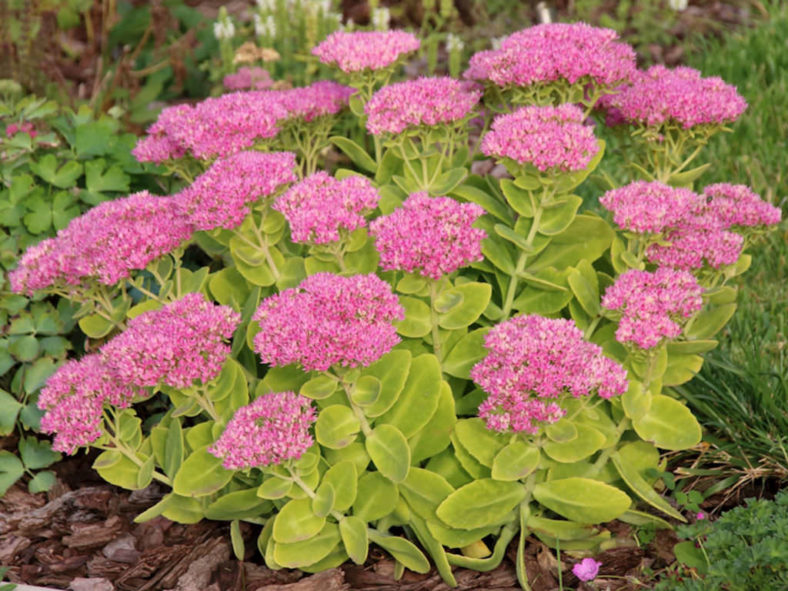Hylotelephium is a genus of about 33 species of succulent plants in the family Crassulaceae native to Asia, Europe, and North America. You might not be familiar with this genus. Still, most gardeners have seen or are growing Hylotelephiums without knowing it because they are a group of species segregated from the genus Sedum. They are commonly known as Border Stonecrops, Border Sedums, or Upright Sedums.
The Japanese botanist Hideaki Ohba described the genus in 1977 based on its type species, Hylotelephium telephium.
Hylotelephiums are mainly tall, perennial plants with usually thick and sometimes tuberous roots. They die down in winter, then shoot up again in spring. These popular garden plants are undemanding, not aggressive, with fleshy, drought-resistant foliage and lovely domed flower heads packed with a profusion of tiny, star-shaped flowers that appear in late summer or early fall. The flowers come in different shades of white, pink, or red. All species have more or less edible leaves and roots.
Gardening enthusiasts and professional horticulturists have hybridized many species to create many new and well-known Hylotelephiums. There are hundreds of cultivars and hybrids. Hylotelephium 'Herbstfreude', also known as Hylotelephium 'Autumn Joy', is perhaps the most well-known of this group.
The generic name "Hylotelephium" derives from the Greek words "hylo," meaning "forest or woodland," and "telephium," meaning "distant lover."

Growing Conditions for Hylotelephium
These popular garden plants are easy to grow. Hylotelephiums are ideal for that part of your garden that gets too much sun or too little water to grow anything else. They also grow well in containers.
Light
Hylotelephiums prefer full sun. They tolerate light to partial shade in hot summer climates but produce weak, floppy growth when grown in deep shade or overly rich soils. Plant Hylotelephium in an area of your garden that gets 6 hours of sunlight daily.
Soil
These succulents do not need rich soil, but they do need excellent drainage. Choose a commercial potting mix for succulents, or make one yourself. A clay pot with drainage holes is the best container for growing Hylotelephiums.
Temperature
Hylotelephiums are heat-tolerant, drought-resistant, and cold-hardy, making them popular outdoor plants. Hylotelephiums can withstand freezing temperatures. Most will tolerate temperatures down to USDA hardiness zone 3a, -40 °F (-40 °C).
General Care for Hylotelephium
Hylotelephiums are known as low-maintenance plants.
Watering
These succulents are drought-tolerant once established. The best way to water Hylotelephiums is to use the "soak and dry" method. Get the soil completely wet, and then wait until it is dry before watering again.
Fertilizing
Feed annually with a balanced fertilizer. According to package directions, apply the fertilizer to the soil in spring as new growth appears.
Repotting
Plants in containers do require little more care than those in gardens. Repot your plants when they outgrow their current pot by moving them to a larger pot to hold the plant better. Spring is the best time to repot Hylotelephiums. Make sure the soil is dry before you begin the repotting process.
Pruning
Prune Hylotelephium plants after flowering to maintain the shape or leave old flower heads to overwinter as an attractive addition to your garden. Pruning in late spring or summer creates shorter stems with more branching but will delay bloom time.
How to Propagate Hylotelephium
Hylotelephiums can be grown from seeds, division, or stem cuttings.
Seeds
Sow seeds in spring in well-drained soil mix in a sunny position. Do not allow the soil to dry out. Plant the seedlings into individual pots when they are large enough to handle.
Division
Dividing your Hylotelephium is easy and can be carried out at almost any time in the growing season, though it is probably best done in spring or early summer. Larger divisions can be planted out directly into their permanent positions.
Stem Cuttings
Propagate by stem cuttings in summer. Take a cutting from a healthy plant and strip off the leaves from the bottom inch (2.5 cm) or so. Allow cuttings to dry out before they can be planted in well-drained soil.
Pests and Diseases of Hylotelephium
There are no serious pests or disease problems with Hylotelephium in particular. In some instances, slugs, scale, mealybugs, nematodes, aphids, and weevils may appear.
Toxicity of Hylotelephium
Hylotelephium plants can be mildly toxic to humans and animals when ingested.
Links
- Back to genus Hylotelephium
- Succupedia: Browse succulents by Scientific Name, Common Name, Genus, Family, USDA Hardiness Zone, Origin, or cacti by Genus